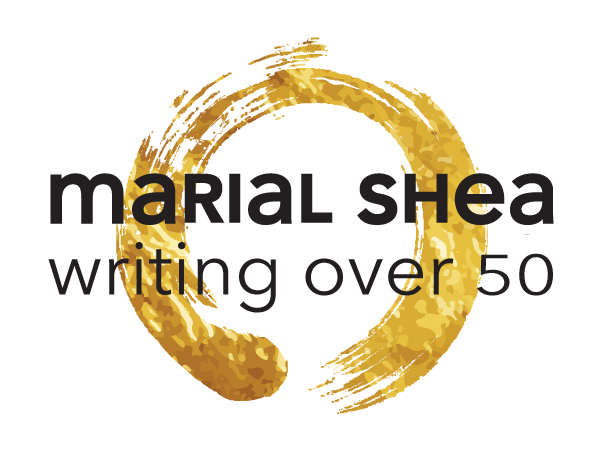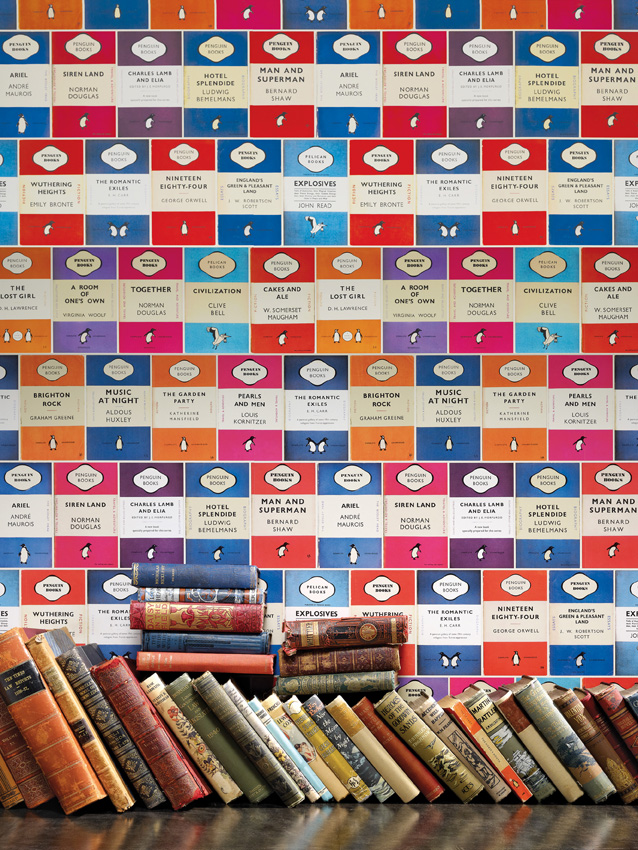Talking back to books.
Great Writing Advice from 3 Pro Bloggers
Where do you go for great advice about writing and freelancing? Start here, with three of my favourite posts of the week, from three reliably savvy bloggers.
 First off is my fellow Vancouverite Daphne Gray-Grant, the “Publication Coach.” She dishes out a steady stream of sharp advice on writing “faster and better,” for both beginners and pros. Check out her post, 5 Stupidly Simple Ways to Improve Your Writing.
First off is my fellow Vancouverite Daphne Gray-Grant, the “Publication Coach.” She dishes out a steady stream of sharp advice on writing “faster and better,” for both beginners and pros. Check out her post, 5 Stupidly Simple Ways to Improve Your Writing.
Next, Carol Tice offers six empowering tips on how to get started as a freelance writer in The Advice I Wish I’d Had as a New Freelance Writer. “I’m kind of obsessed with helping writers earn more from their work,” writes Carol on her website, Make a Living Writing.
And last, but definitely not least, is the lovely Alexandra Franzen. Her post, I spent an hour with The Oprah Whisperer. (Oh yeah!) Here’s what I learned about telling a soundbite-sized story … lays out a five-point guide to the essential art of “story-shrinkifying.”
Happy reading!
Creativity Tips from Psychology Today
The June issue of Psychology Today presents research on creativity that lends weight to two of my recent blog posts, and a number of my closely held beliefs. Which, I’m sure, is their main purpose over there at Psychology Today: looking for solid evidence to shore up my personal theories.
 “The Enemies of Invention” explores five “stealth saboteurs” of our creative process in five short articles. It strikes me that Austin Kleon covers similar territory in his book Steal Like An Artist (which I wrote about here) without once mentioning scientific studies. But it’s nice to don our vicarious lab coats once in a while, isn’t it?
“The Enemies of Invention” explores five “stealth saboteurs” of our creative process in five short articles. It strikes me that Austin Kleon covers similar territory in his book Steal Like An Artist (which I wrote about here) without once mentioning scientific studies. But it’s nice to don our vicarious lab coats once in a while, isn’t it?
Christopher J. Sprigman and Kal Raustiala present their version of “Steal Like An Artist” in their piece “The Downside of Avoiding Imitation.” They write:
Very little, if anything, is wrought out of nothing. In practice, creativity is a cumulative process, one that often involves tweaking, adapting, and melding existing creations.
In support of this goal of encouraging a greater migration of ideas, they propose that “too much legal protection” in the form of patent and copyright laws “actually makes it hard to be truly creative.” They argue that shorter periods of protection would lead to more, not less, creative output.
In “Fear of Failure Narrows Vision,” Peter Gray presents research showing that
In physically demanding tasks, like lifting heavy weights, and in tedious tasks, like counting beans, we do better when we are being evaluated than when we are not. But in tasks that require creativity, new insights, or learning, we do better when we are not being evaluated, so are not afraid of failure.
This resonates nicely with the story I quoted in this post from Art and Fear, about the ceramics teacher dividing his class into two groups, and showing that the group being graded by volume of output produced more creative pots than those assigned the making of a single perfect pot.
Gray notes that, from an evolutionary perspective, we can be creative only when we do not feel that our survival is under threat. But being evaluated “when it is not asked for and when it has consequences” causes us to feel threatened. Therefore, being evaluated locks down our creative process.
Gray cites experiments by Harvard Business School psychologist Teresa Amabile in which she had participants create a poem, story or artwork. She told one group their work would be evaluated by experts, another that theirs would be entered into a contest, while a third group was told nothing. Consistently, the most creative work (according to a panel of experts!) was produced by those who did not know they were being evaluated.
Check out the Psychology Today article for three more insightful pieces on creativity crushers and how to avoid them. Then, get out there and make those pots/poems/blog posts. Steal like an artist. Go for quantity.
Osborne & Little’s New Wallpaper Captures Beloved Penguin Classics
The inspired British fabric and wallpaper designer Osborne & Little has brilliantly married two of my obsessions, books and interior design, in their recently released Penguin Library wallpaper. With this collage of front covers from the famous Penguin publishing house, you can now have these iconic tri-banded paperbacks covering your walls without all that annoying reading!
Launched in 1935, the Penguin paperbacks not only broke the book-design mold, but their low prices made quality literature more accessible than it had ever been. According to the Osborne and Little press release:
The Penguin tri-band design was the work of Edward Young, a 21-year-old office junior who went on to become the company’s first Production Manager, who was also dispatched to London zoo to sketch a penguin for the now well-recognised and much-loved logo. The template he created consisted of three horizontal stripes: upper and lower bands colour coded by genre … and a central white panel containing the author and, of course, they came printed with the iconic Penguin logo. The distinctive simplicity was a radical departure from the more ornate approach of its competitors and spoke volumes about the new company.
The Saturday Papers
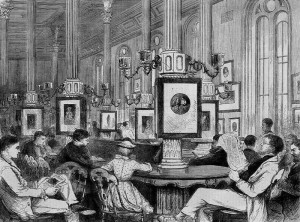
The reading room of the Boston Public Library, an engraving drawn by J. J. Harley and printed January 1871 in Every Saturday, a weekly newspaper published in Boston by James Osgood & Co.
On Saturdays, one of my simple pleasures is going to the local library and reading the Saturday papers. My favourite is the Globe and Mail, because of the smart writing and insightful arts coverage.
But my friend John, a retired career advisor, also reads the Saturday Globe, and we tend to show up around the same time, so there’s an unspoken competition as to who will get the paper first. Usually, he wins. Today, as usual, I walked into the library and spotted him at one of the centre tables, bent over the pages of the Saturday Globe.
So I sat down in the lounge area with the Vancouver Sun instead. Until Mr. Chan came and sat down beside me. Mr. Chan is 93 years old and a former neighbour. He’s a photographer, and he interrupted my reading to shyly ask for help getting his downloaded photos moved from his flash drive to his computer so he could crop them.
I work on Macs and he uses an ancient PC, so I didn’t know how to find much of anything on his laptop. Plus Mr. Chan is nearly deaf, and it’s the damn library, so I’m trying to ask him questions without making too much noise.
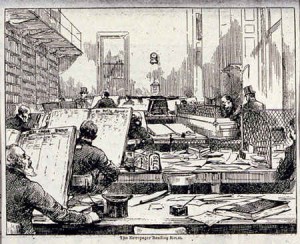
The Old Newspaper Reading Room in the British Museum Bloomsbury. Sell’s Dictionary of the World’s Press 1893. Copyright ©1999, The British Library Board.
We didn’t accomplish much beyond cropping and saving one photo and making a tentative date for future efforts. Guess I’ll have to do a little research about saving files and working with photos on PCs.
Then a young woman came into the lounge with a tiny crying infant. I think she had some kind of disability, like fetal alcohol syndrome. While she nursed the baby, we talked about how she’d been up since six this morning and had taken the baby swimming. She said she was too tired to go to her church meeting tonight, which starts at 6 and goes until 10. I helped her pack up her stuff while the baby dozed off in the stroller.
All of which is to say, I still have the Saturday Globe to read. It’s just as good on Sunday.
Poetry Deficiency? Billy Collins Can Help
American poet Billy Collins believes poetry should be out rubbing shoulders with the rabble:
“When you get a poem on a billboard or on the radio or on a cereal box, it happens to you so suddenly that you don’t have time to deploy your anti-poetry deflector shields that were installed in high school.”
Collins’ popularity as a poet may well be unprecedented in our time. Having served two terms as US Poet Laureate (as he himself loves to point out), he speaks to us of suburban middle-class life in language ordinary people understand. His readings regularly sell out and he has received six-figure advances for recent books.
All of that aside, I just love his poems. I listened to a recording of him reading his poem “Forgetfulness” years ago, and I still think of it often. Everyone I’ve ever read it to has asked for a copy. I think we recognize ourselves in his words. I love hearing the audience respond to his reading of that poem.
In his 2012 Ted Talk, he gives us what he calls our “recommended dietary allowance of poetry.” The talk includes animations of several of his poems, a marriage of mediums he initially doubted, until he realized it would “get poetry on television.” The funniest poem in the Ted Talk, though, is the last one, with no animation, a deliciously tongue-in-cheek commentary on adolescence.
You’re looking a bit poetry deficient yourself. You’d better click play.
Guest Post: Write Your Professional Bio — Today!
I’m excited to report that my first guest blog post went live today, on Kellie deRuyter’s website. Kellie is a certified coach who teaches her powerful marketing system to new and seasoned coaches. She’s a dynamic and dedicated coach and an all-round delightful human. I’m honoured that she invited me to contribute to her blog.
Since Kellie’s focus is on helping coaches promote their services, I whipped up a post on that essential self-marketing tool, the professional bio. I clarify what a bio is (and isn’t, so you know what not to do). I also supply a handy 10-point cheat sheet and a fill-in-the-blanks template to guide you through writing your bio. The post is addressed to coaches, but the method works for anyone.
Have a peek, and if you’ve got any questions about writing your bio (or you’d like to hire me to write it for you), get in touch!
2 Online Tools to Simplify Your Reading and Writing
Some people need noise to concentrate: background music, the hiss of an espresso machine, the latest rotation on their personal listening device.
Not me. I need quiet — and I don’t just mean the soundscape. I need visual quiet too. This is why web apps like the popular Evernote don’t work for me. Not only do I find Evernote visually busy, but the learning curve to use all its features takes away from my work time instead of adding to it.
If you’re a simplicity freak like me, here are two online tools you might enjoy.
Take Your Morning Pages Online with 750Words
Are you a fan of Julia Cameron’s morning pages? Then you’ll want to check out Buster Benson’s ultra-nifty 750Words.
The basic idea of morning pages is to write three pages every day in stream-of-consciousness style, to clear your mind and stoke your creative fire. Cameron introduced morning pages as a longhand practice with a pen and paper journal.
But why not experiment with typing online instead? Buster Benson created 750Words, an elegantly simple online framework for doing your morning pages. You might love it. I do. It’s not blogging: your writing is totally private, just for you.
Nope, you can’t change the font or add fancy formatting or do anything else that will distract you from writing. The website is almost invisible — once you join, you just log in and start writing. No learning curve.
Your work is automatically saved, and you get a message when you hit the 750-word mark. You can export your entries if you like. I export mine at the end of every month and print them up.
You can earn points for writing your quota each day, get funny little animal badges and track your metadata (Benson is a metadata fanatic). Or you can just write.
It’s pretty interesting to watch your total word count pile up. I’ve now written over a hundred thousand words. Wow!
I started supporting 750Words with a $5-a-month donation a while back, when the site was free. Yes, I love it that much. You can still try the site for free for 30 days, but now Benson and his sweetie-pie are charging $5 a month to help cover their costs and time. If you really don’t have the five bucks, though, they’ll give you a free pass if you plead your case.
Clear the Way to Easy Reading with Readability
Readability is a free web app that you install in your browser. (Hey, if I can do it, so can you.)
You know those times when you find an intriguing article on a website, but you can hardly read it because the site is such an eyeball-busting cacophony of boxes, columns, pop-ups and graphics?
Well, just click the Readability icon and … presto, a clean web page opens with n o t h i n g b u t y o u r a r t i c l e . Oh, wait till you see, it’s a thing of beauty, like when the neighbours finally turn down their stereo after hours of thumping base. Breathing space for your eyes. Room to think. (Remember thinking?)
You can customize the style and type size you want. And you can save articles to read later.
Readability works for smartphones and tablets too.
I think you might like it.
A Blog Post a Day Keeps Perfectionism Away
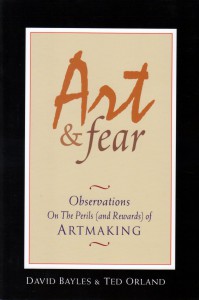 Yesterday I fell under the wheel of some deadline pressures and a friend suggested I stop this Blogathon madness. “A couple of posts a week is enough,” she said sympathetically. “You don’t need to post every day.”
Yesterday I fell under the wheel of some deadline pressures and a friend suggested I stop this Blogathon madness. “A couple of posts a week is enough,” she said sympathetically. “You don’t need to post every day.”
In that moment, I realized why I’m doing the WordCount Blogathon challenge: it’s my antidote to fear (which I wrote about on day 1 of the Blogathon) and crippling perfectionism.
This realization made me remember one of the most revelatory passages I’ve ever read on the creative process. It’s from a superb little book by David Bayles and Ted Orland called Art and Fear: Observations on the Perils (and Rewards) of ARTMAKING.
The ceramics teacher announced on opening day that he was dividing the class into two groups. All those on the left side of the studio, he said, would be graded solely on the quantity of work they produced, all those on the right solely on its quality. His procedure was simple: on the final day of class he would bring in his bathroom scales and weigh the work of the “quantity” group: fifty pounds of pots rated an “A,” forty pounds a “B” and so on. Those being graded on “quality,” however, needed to produce only one pot — albeit a perfect one — to get an “A.” Well, came grading time and a curious fact emerged: the works of highest quality were all produced by the group being graded for quantity. It seems that while the “quantity” group was busily churning out piles of work — and learning from their mistakes — the “quality” group had sat theorizing about perfection, and in the end had little more to show for their efforts than grandiose theories and a pile of dead clay.
So, for the month of June, I’m aiming for quantity: a post a day. I’ve given enough of my creative life to the futile pursuit of perfection — which has indeed largely involved sitting around “theorizing,” as Bayles and Orland so aptly put it. They also point out that the very idea of perfection is, ironically enough, “a flawed concept.”
Only out of our imperfections do we learn, grow and create.
3 Lessons in Storytelling from Sir Patrick Stewart
Sir Patrick Stewart, aka Captain Jen-Luc Picard, was a special guest at Comicpalooza in Houston, Texas, last month. During a Q&A, audience member Heather Skye thanked him for his 2007 Amnesty talk on domestic violence. She then asked him, “besides acting, what are you most proud of that you’ve done in your life?”
There’s so much to praise in the content of Sir Patrick’s speech — especially his bold stand against male violence towards women. But as a writer, I’m fascinated by the storytelling genius that’s earned this video well over three million hits in just a few days.
What can we learn as writers and entrepreneurs from this gifted speaker?
In his speech, Patrick Stewart demonstrates three things we all need to do as storytellers, whether we’re using story in our writing or as entrepreneurs marketing our business:
- Connect with the audience.
- Inject exactly the right amount of story to create emotion.
- Lead (or persuade) by connecting the dots.
1. Connect with the audience.
 Stewart begins his response by acknowledging his questioner directly for making the connection between his work as an actor and as an activist. He says to her:
Stewart begins his response by acknowledging his questioner directly for making the connection between his work as an actor and as an activist. He says to her:
I think you have beautifully linked the important things together.
He stays continuously attuned to the audience, not just talking at people, but observing their reactions. At one point (6:40), he gives a nod to the men who are applauding him, praising their support against domestic violence.
As writers, we need to cultivate a continuous feedback loop, listening to our own words while imagining the perceptions and needs of our readers. What are they thinking and feeling? Do they need a beat of silence? More explanation? A fiery anecdote? Some cool facts?
2. Use exactly the right amount of story to create emotion.
After introducing domestic violence as a social issue, Stewart humanizes it by telling us why he’s involved:
I do what I do in my mother’s name … because I couldn’t help her then…. Now I can.
With just these few words of (mostly implied) story, we immediately feel for his mother. He doesn’t go into detail; he knows he doesn’t need to. What he says is enough to draw us in.
Then, after leading us to believe this is a story about his mother, he takes a left turn: “Last year,” he says, “I learned things about my father that I didn’t know.” He tells how his father returned home from fighting in the Second World War with what was then dismissed as “shell shock.”
Now, unexpectedly, we feel for his father.
But before we settle into his father’s story, he expands our empathy exponentially. He connects his father’s plight with that of the many soldiers all over the world today who are returning home with what we now recognize as post-traumatic stress disorder.
3. Lead (or persuade) by connecting the dots.
Stewart has now told us about his mother and connected the violence she suffered to the combat trauma his father experienced.
He has connected what was originally known as shell shock with what we now call PTSD, and the profound social damage it causes.
He has connected the universal social issues of violence against women and PTSD with his own personal history, then traced his family’s story back out to the big picture. He has connected the past with the present.
And he connects the men in the audience with the work that needs to be done.
In closing, he pulls it all together:
So, I work for [the organization] Refuge for my mother, and I work for Combat Stress for my father in equal measure.
He does all this in less than eight minutes. And, like all great storytellers, he makes it look easy.
Stealing Creative Inspiration from Austin Kleon
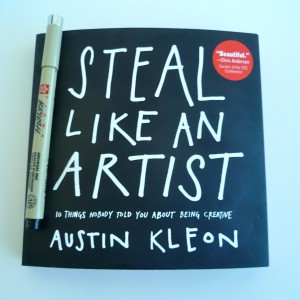 I don’t know about you, but I own way too many books on writing and creativity. And what have most of them done for me other than distract me from actually writing and creating?
I don’t know about you, but I own way too many books on writing and creativity. And what have most of them done for me other than distract me from actually writing and creating?
Still, every now and then a total gem comes along. Like Austin Kleon’s Steal Like an Artist: 10 Things Nobody Told You About Being Creative.
Could this cool, six-inch-square graphic delight be any cuter? Talk about “the medium is the message”: every element of the book’s design embodies Austin’s hands-on ethos. You wouldn’t think black and white could be reinvented, but these pages, with their hand-drawn print, photos and doodles, feel fresh and new.
And there’s great content too, including some of the most solidly usable advice for living a creative life I’ve found. Here’s what sets this book apart from other books on creativity, at least for me: it kicks me into action.
You don’t have to consider yourself an artist or writer to benefit from Steal Like an Artist. Austin wrote it for “anyone who’s trying to inject some creativity into their life and their work. (That should describe all of us.)”
Here are three of my favorite Kleon commandments:
1. Step away from the screen.
“You need to find a way to bring your body into the work,” writes Austin.
It wasn’t until I started bringing analog tools back into my process that making things became fun again and my work started to improve.
I got so excited when I read about his dual-desk work setup that I copied it: one desk for digital equipment and the other for analog. Austin allows nothing electronic on his analog desk, just tools for writing, doodling, drawing, making notes. This is where he germinates ideas and mucks around. Only when he’s ready to pull something together and publish it does he moves to his digital desk.
2. Build your own world.
This reminds me of Pema Chodron’s famous adage, “start where you are,” only Austin is telling us to “create where you are.” He lives in one of the country’s hippest cities, yet most of his peers don’t live there. “I know them from the Internet,” he says.
You don’t have to live anywhere other than the place you are to start connecting with the world you want to be in … Surround yourself with books and objects that you love. Tape things up on the wall. Create your own world.
Connect with great people online, put on some music, pay attention to what’s around you.
3. Start making stuff.
Don’t wait until you know who you are before you make things.
In my experience, it’s in the act of making things and doing our work that we figure out who we are. You’re ready. Start making stuff.
Fake it till you make it. Copy your heroes. Work it out by doing it.
Want More Austin Kleon?
Check out this talk he gave in May, buy his book, spend some time on his websites. He’s a busy guy. You better get started.
Blog posts
No Results Found
The page you requested could not be found. Try refining your search, or use the navigation above to locate the post.
